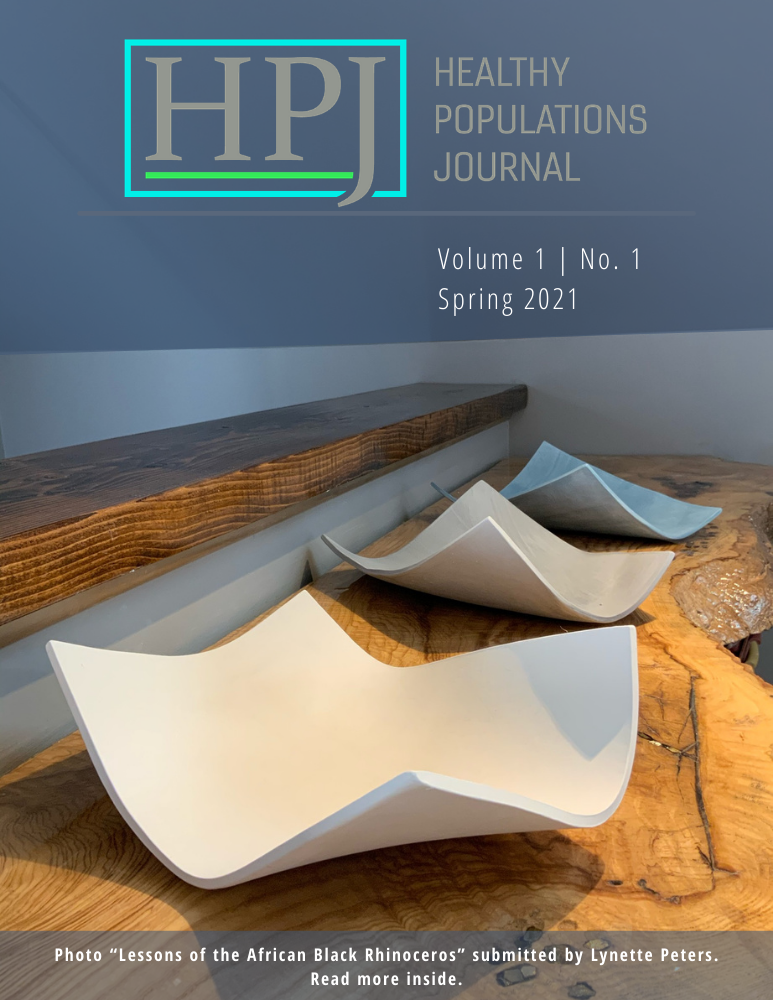Assessing the Representation of People of African Descent on Nova Scotia‘s Community Health Boards
DOI:
https://doi.org/10.15273/hpj.v1i1.10585Abstract
According to the Health Authorities Act (Section 62), Community Health Boards (CHBs) in Nova Scotia are intended to “contribute to health-system accountability by facilitating an exchange of information and feedback between the community and the provincial health authority.” The present situation, however, is one in which health boards may not represent the demographic diversity of the community. This challenge may be particularly prevalent within African Nova Scotian communities. This paper will quantify whether people of African descent who serve on CHBs match the demographics of the community and discuss whether any discrepancies may affect policy initiatives within Nova Scotia Health. To answer these questions, we conducted a demographic analysis of 31 CHBs. The representation of African Nova Scotian participants on CHBs (5%) exceeds their representation within the total provincial population (2.4%); however, by removing the Southeastern Board, the representation of African Nova Scotians mirrors their representation in Nova Scotia as a whole. African Nova Scotians are overrepresented, to some extent, on CHBs. This overrepresentation is a factor of small sample size and skewed distribution. Even in historically African Nova Scotian communities like the Southeastern Board (with 85% of residents identifying as African Nova Scotians), the board demographics do not match the demographics of the communities they serve. Given the unique challenges African Nova Scotians face within Nova Scotia‘s health system, representation on all boards may be necessary. The challenges of robust engagement of marginalized communities could be addressed by dedicated recruitment efforts by Nova Scotia Health. Further, the lack of demographic information collected by either CHBs or by Nova Scotia Health presents an inability to address critical concerns within the African Nova Scotian community.
References
Abelson, J., & Eyles, J. (2004). Public participation and citizen governance in the Canadian health system. In P. Forest, G. P. Marchildon, & T. McIntosh (Eds.), Changing health care in Canada: The Romanow papers (Vol. 2). (pp. 279–311). University of Toronto Press.
Adams, B. (2004). Public meetings and the democratic process. Public Administration Review, 64(1), 43–54. https://doi.org/10.1111/j.1540-6210.2004.00345.x
Armstrong, P. (2009). Social cohesion and the neoliberal welfare state: The health care example. In A. Dobrowolsky (Ed.), Women & public policy in Canada: Neo-liberalism and after? (pp. 87–107). Oxford University Press Canada.
Bill No. 1: Health Authorities Act. (2014). 1st Reading Sep. 29, 2014, 62nd General Assembly, 2nd Session, Nova Scotia. http://nslegislature.ca/legc/bills/62nd_2nd/1st_read/b001.htm
Black, M., & Fierlbeck, K. (2006). Whatever happened to regionalization? The curious case of Nova Scotia. Canadian Public Administration, 49(4), 506–526. https://doi.org/10.1111/j.1754-7121.2006.tb01996.x
Bradshaw, P., & Fredette, C. (2013). Determinants of the range of ethnocultural diversity on nonprofit boards: A study of large Canadian nonprofit organizations. Nonprofit and Voluntary Sector Quarterly, 42(6), 1111–1133. https://doi.org/10.1177%2F0899764012453085
Chung, P., Grogan, C. M., & Mosley, J. E. (2012). Residents‘ perceptions of effective community representation in local health decision-making. Social Science & Medicine, 74(10), 1652–1659. https://doi.org/10.1016/j.socscimed.2012.01.029
Clancy, P. (1997). Concerted action on the periphery? Voluntary economic planning in “the new Nova Scotia”. Acadiensis, 26(2), 3–30. https://www.jstor.org/stable/30303138
Coglianese, C. (2002). Is satisfaction success? Evaluating public participation in regulatory policymaking (KSG Working Paper No. RWP02-038). John F. Kennedy School of Government Faculty Research Working Paper Series. http://dx.doi.org/10.2139/ssrn.331420
The Commission on Effective Electoral Representation of Acadian and African Nova Scotians. (2018). Representation: Toward more effective representation for Acadian and African Nova Scotians. https://novascotia.ca/representation/Representation-Toward-More-Effective-Representation-For-Acadian-and-African-Nova-Scotians-Report-and-Recommendation.pdf
Department of Health. (1996). Regional health board members announced. Government of Nova Scotia. https://novascotia.ca/cmns/msrv/viewRel.asp?relID=/cmns/msrv/nr1996/nr96-12/96120903.htm
Etowa, J., & Debs-Ivall, S. (2017). Leadership and organizational commitment to ethno-cultural diversity in healthcare. Journal of Ethnographic & Qualitative Research, 11(4), 277–292.
Fitzgerald, C., McCarthy, S., Carton, F., Connor, Y., Lynch, L., & Adam, F.
(2016). Citizen participation in decision-making: Can one make a difference? Journal of Decision Systems, 25(sup1), 248–260. https://doi.org/10.1080/12460125.2016.1187395
Galabuzi, G.-E. (2012). Social exclusion as a determinant of health. In E. A. McGibbon (Ed.), Oppression: A social determinant of health (pp. 97–112). Fernwood Publishing.
Gingrich, L. G., & Lightman, N. (2015). The empirical measurement of a theoretical concept: Tracing social exclusion among racial minority and migrant groups in Canada. Social Inclusion, 3(4), 98–111. https://doi.org/10.17645/si.v3i4.144
Halvorsen, K. E. (2003). Assessing the effects of public participation. Public Administration Review, 63(5), 535–543. https://doi.org/10.1111/1540-6210.00317
Howe, P. (2011). Citizens adrift: The democratic disengagement of young Canadians. UBC Press.
Hurley, J., Lomas, J., & Bhatia, V. (1994) When tinkering is not enough: Provincial reform to manage health care resources. Canadian Public Administration, 37(3), 490–514. https://doi.org/10.1111/j.1754-7121.1994.tb00874.x
Lewis, S., & Kouri, D. (2004). Regionalization: Making sense of the Canadian experience. HealthcarePapers, 5(1), 12–31. https://doi.org/10.12927/hcpap.2004.16847
Maynard, R. (2017). Policing Black lives: State violence in Canada from slavery to the present. Fernwood Publishing.
Minister‘s Action Committee on Health System Reform. (1994). Nova Scotia‘s blueprint for health system reform. Nova Scotia Department of Health.
Nova Scotia Community Health Boards. (n.d.). About us: “Community partnerships and a voice for a healthier future”. https://www.communityhealthboards.ns.ca/about#bio
One Nova Scotia. (n.d.). Goal 8: Employment rate – First Nations and African Nova Scotians. https://www.onens.ca/goals/goal-8-employment-rate-first-nations-and-african-nova-scotians
Reddel, T., & Woolcock, G. (2004). From consultation to participatory governance? A critical review of citizen engagement strategies in Queensland. Australian Journal of Public Administration, 63(3), 75–87. https://doi.org/10.1111/j.1467-8500.2004.00392.x
Rowe, G., & Frewer, L. J. (2004). Evaluating public-participation exercises: A research agenda. Science, Technology, & Human Values, 29(4), 512–556. https://doi.org/10.1177/0162243903259197
Schmidt, V. A. (2013). Democracy and legitimacy in the European Union revisited: Input, output and ‘throughput‘. Political Studies 61(1), 2–22. https://doi.org/10.1111/j.1467-9248.2012.00962.x
Statistics Canada. (2016). Census profile, 2016 census: Nova Scotia. https://www12.statcan.gc.ca/census-recensement/2016/dp-pd/prof/
Tolley, E. (2019). Who you know: Local party presidents and minority candidate emergence. Electoral Studies, 58, 70–79. https://doi.org/10.1016/j.electstud.2019.02.007
Vigoda, E. (2002). From responsiveness to collaboration: Governance, citizens, and the next generation of public administration. Public Administration Review, 62(5), 527–540. https://doi.org/10.1111/1540-6210.00235
Waldron, I. R. G. (2016). Experiences of environmental health inequities in African Nova Scotian communities. The ENRICH Project. http://www.enrichproject.org/wp-content/uploads/2016/10/Final-Environmental-Racism-Report.pdf
Wane, N. N. (2005). African women and Canadian history: Demanding our place in the curriculum. In V. Zawilski & C. Levine-Rasky (Eds.), Inequality in Canada: A reader on the intersections of gender, race, and class (pp. 156–167). Oxford University Press.


